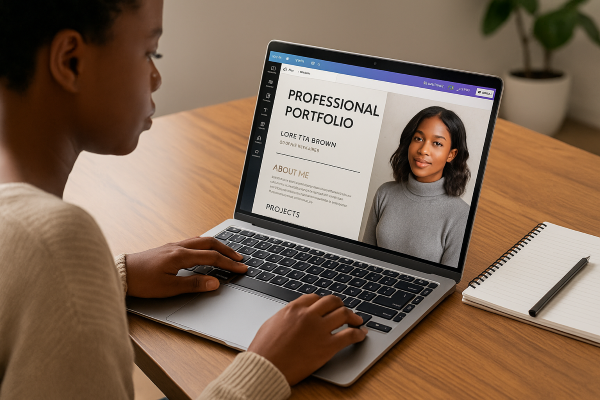Anúncios
Show your skills clearly and score points before the interview!

A professional portfolio is more than just a presentation tool. It’s a way to show everything you excel at in a practical format.
Even in operational jobs, where action matters more than theory, a well-made document can convey confidence and capability right away.
Organizing your experience, training, and skills in a clear, visual format can be the boost you need to stand out in the hiring process.
Curious how this tool can improve your image? Then keep reading to discover why operational professionals should absolutely have a portfolio!
Why Operational Professionals Should Also Have a Portfolio
Many believe only designers need portfolios, but learning how to create a portfolio for operational jobs can truly set you apart.
With the job market more competitive than ever, presenting your value clearly is essential, and a portfolio can be your secret weapon.
How a Portfolio Can Highlight Your Profile
Even in hands-on roles, showcasing your practical skills with clarity can make your resume stronger and attract more recruiter attention.
By organizing your experiences visually and objectively, you show confidence and commitment to your career path.
A well-structured professional portfolio shows initiative and helps recruiters match your profile with the position more quickly.
Key Traits That Impress Recruiters
Recruiters value simple things: neat structure, clear descriptions, and a proactive approach when presenting your background visually and intentionally.
Adding short testimonials or certificates boosts your profile and shows you’re always looking to grow, even in routine roles.
When you submit a professional portfolio without being asked, you’re already ahead by showing preparation and genuine interest.
What Every Operational Portfolio Must Include
Many people ask how to create a portfolio for operational jobs, but few know what actually belongs in one.
To truly stand out with clarity and purpose, you must organize the information that reflects your day-to-day strengths.
Basic Information and Contact Details
Don’t underestimate the power of basics: your name, phone number, and email—clearly placed—already show professionalism and organization.
Also include your city, work availability, and if possible, a link to WhatsApp or LinkedIn with an updated and friendly profile.
These elements are the foundation of any professional portfolio and make it easy for recruiters to reach out right away.
A Straight-to-the-Point Professional Summary
Your summary should be short and direct, highlighting years of experience, areas of focus, and one or two key strengths.
Skip exaggerations or clichés. Be honest and show commitment without promising more than you can deliver.
The goal is to spark curiosity so the recruiter wants to explore the rest of your content.
Well-Described Practical Experience
List your experiences clearly, with company name, time period, and the main tasks you were responsible for.
Highlight real results whenever possible, such as improving processes, saving time, or increasing productivity.
These details show your true impact and help set you apart from others with similar roles.
Relevant Certifications and Courses
Include technical courses, refreshers, and training—even short ones—all of it adds value to your operational profile.
Use plain language when listing courses: just the name, institution, and year are enough to show a desire to grow.
If you have essential certifications like forklift or safety training, use icons or visual cues to help them stand out.
How to Present Your Experience Clearly and Effectively
Avoid long paragraphs. Use bullet points and bold text to highlight duties, achievements, and key professional portfolio information.
Sort everything by importance, starting with your most recent or most relevant experiences for the job you’re aiming for.
Adding icons or images next to descriptions helps visualize your work and makes your material more engaging.
Tips to Make Your Portfolio More Appealing
If you already know how to create a portfolio for operational jobs, now it’s time to make it more visually appealing.
With a few layout tweaks, your material can shine and make the recruiter’s job much easier.
Choose a Clean and Professional Visual Format
Avoid flashy fonts or overly colorful backgrounds. A clean layout gives your professional portfolio a more serious and polished look.
Stick to neutral colors and simple elements. The focus should be your experience, not distracting graphics or visual clutter.
Templates help, but always review the final layout. A well-formatted document shows care and attention to detail.
Use Icons and Visual Elements to Improve Readability
Icons help guide the reader’s eyes and break up large text blocks, making content easier and more pleasant to read.
Simple symbols like phone, email, calendar, or certificate can represent key information in your professional profile.
The goal isn’t to decorate too much, but to make it easier for recruiters to find what they need quickly.
Keep It Light and Straightforward
Your portfolio doesn’t need to be long. Less is more when everything is well-organized and gets straight to the point.
Avoid repeating yourself. Every page should clearly show a skill, achievement, or relevant experience.
Leave space between sections. This gives the reader breathing room and avoids a cramped or cluttered look.
Adapt the Portfolio to Different Job Types
If you’re applying to different types of jobs, customize your professional portfolio to highlight what each position values most.
Keep the overall structure, but switch out experiences or training depending on the role you’re aiming for.
This small effort shows you thought about the company, which always earns you points during selection.
Easy Tools to Build Your Portfolio
Wondering how to create a portfolio for operational jobs without complications? There are plenty of simple, useful tools available.
You don’t need to be a design expert. The secret is picking platforms that are intuitive and well-structured.
How to Use Canva to Build a Portfolio from Scratch
Site

Canva
Canva offers great templates. Choose a clean layout, add your details, and turn it into a professional portfolio in a few clicks.
It’s easy to use. You can drag blocks, add icons, and even upload photos from your actual workplace.
Always save your work to the cloud. That way, you can edit or update it anytime without losing quality or formatting.
Word and PowerPoint Work Too
If you prefer familiar tools, Word and PowerPoint are great for building simple, clean-looking presentations.
Pick a resume or presentation template and replace the text with your own content. It works perfectly for operational roles.
When finished, export as PDF so the layout looks consistent on any device or browser.
Bonus Tip: Save as PDF and Keep It Updated
Nothing’s worse than a broken file. Always save your professional portfolio as a PDF to avoid display issues.
And keep it up to date. Finished a course? Hit a goal? Add it in before sending the file out.
I recommend reviewing your content every three months. It shows organization and ensures you’re ready when an opportunity comes.
Common Mistakes When Creating a Portfolio
Learning how to create a portfolio for operational jobs also means avoiding what could hurt your professional image.
Dodging common errors can help your portfolio stand out and leave a stronger, more organized impression.
Avoid Long Text and Overly Formal Language
Long text can be overwhelming. Stick to short, clear phrases and get straight to the point in your professional portfolio.
Skip overly fancy or corporate words. Use a friendly, clear tone without losing the professional touch.
Also format visually: use bullet points and spacing when changing ideas or sections on the same page.
Don’t Include Outdated or Generic Information
Leave out jobs or experiences that don’t add value to your current goals. Focus on what matters for the position.
Update after completing a course or leaving a job. Old info makes you seem careless or out of touch.
Remove vague claims like “I’m dedicated.” Instead, show it through real examples or feedback you’ve received.
Take Care with Visual Organization
Messy visuals ruin readability. Use a clear hierarchy: larger titles, proper spacing, and consistent fonts.
Review before finalizing. Check if margins align, icons are consistent, and the structure flows naturally.
A well-organized professional portfolio builds trust. It shows you’re attentive and understand the importance of first impressions.
Conclusion
Now that you know how to build a strong portfolio, it’s time to take the first step and lay out your experience visually.
Remember, the small details matter: choose the right tools, review your content, and tailor it when new opportunities come up.
Avoid overloading the reader and stay focused on what really adds value. Simple, clear portfolios are often the most effective.
Enjoyed the tips? Want to boost your chances even more? Check out the next article and learn how to prepare for practical tests and group exercises!
Recommended Content
